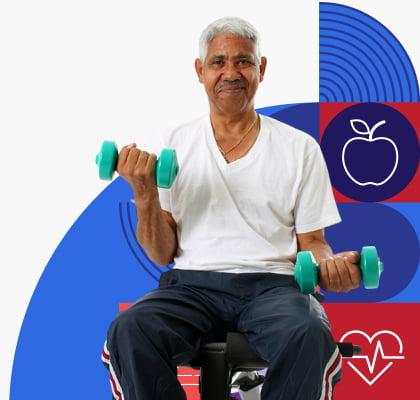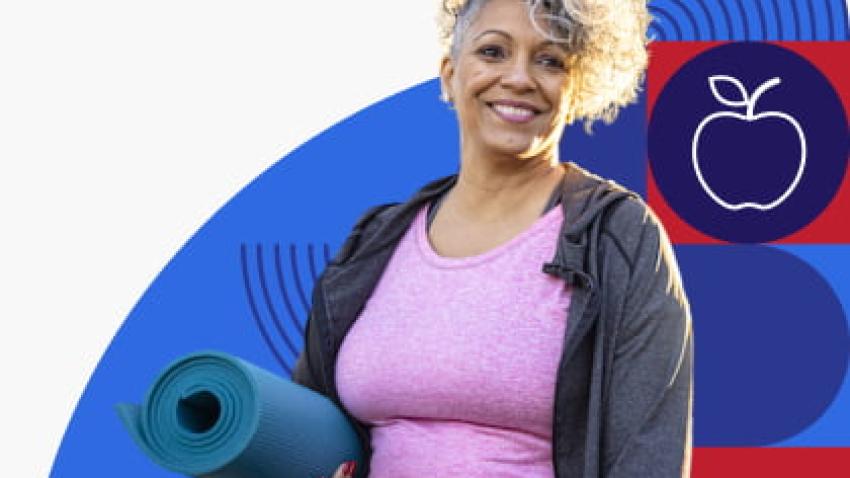Health Conditions
Get Active

The Basics
Overview
Regular physical activity is good for everyone's health! Physical activity is anything that gets your body moving.
Aim for at least 150 minutes of moderate-intensity aerobic activity each week. And at least 2 days a week, do activities that strengthen your muscles.
If you haven't been active before, or you haven't been active for a while, start slowly. Even 5 minutes of physical activity has real health benefits! Once you get the hang of it, add a little more activity each time.
What kinds of activity should I do?
To get all the health benefits of physical activity, do a combination of aerobic and muscle-strengthening activities.
- Aerobic activities make you breathe harder and get your heart beating faster. Walking fast is an example of moderate-intensity aerobic activity. Jogging or running is an example of vigorous-intensity aerobic activity.
- Muscle-strengthening activities make your muscles stronger. Examples include lifting weights, using resistance bands, and doing bodyweight exercises (like push-ups).
Use these resources to learn more about physical activity for:
Health Benefits
What are the benefits of physical activity?
Physical activity increases your chances of living longer. It can also help:
- Control your blood pressure, blood sugar, and weight
- Lower your “bad” cholesterol and raise your “good” cholesterol
- Prevent heart disease, type 2 diabetes, and some types of cancer
And that’s not all. Being more active can:
- Boost your mood
- Help you sleep better
- Make your bones, muscles, and joints healthier
- Lower your chances of becoming depressed
- Lower your risk of falls and reduce arthritis pain
- Help you have fun and feel better about yourself
Is physical activity for everyone?
Yes! Physical activity is good for people of all ages, body types, and abilities. Even if you feel out of shape, or you haven’t been active in a long time, you can find activities that work for you.
Health Conditions
What if I have a health condition?
If you have a health condition like type 2 diabetes or high blood pressure, physical activity can help you manage it. And if you have overweight or obesity, getting active can help you manage your weight and lower your risk of health problems. Ask your doctor what types of activity are best for you if you have a health condition.
You can also:
- Get tips on physical activity and diabetes
- Learn how physical activity helps control high blood pressure
- Find out more about how you can stay active at any size
What if I have a disability?
If you have a disability, you can find safe, fun ways to get active. Talk with your doctor if you need help choosing the best activities for you. You can also use these tips to stay active with a disability.
Take Action
Get Started
Start slowly.
If you haven't been active before, or you haven’t been active for a while, start out slowly and add new activities little by little. After a few weeks or months, do them longer and more often. If you’re not sure where to start, use this tool to build a weekly plan.
Watch this 2-minute video for tips on getting motivated.
Choose activities you enjoy.
Lots of things count as physical activity! Find things you really like to do. Play games like tennis or basketball, take a pilates or martial arts class, or just dance around your living room. Ask your friends to join you.
Any amount of physical activity throughout your day can add up to big health benefits. You can:
- Go for a brisk walk around the neighborhood
- Ride a bike to work — or just for fun
- Do push-ups during commercial breaks in TV shows
Have fun with your family.
You can be a role model for children and other family members. Encourage your whole family to get active outside — go for a hike or organize a family soccer game.
If you can't get active outside, watch this 2-minute video for ways your family can get active indoors.
If someone you love has trouble making time for physical activity, use these tips to help your loved one get more active.
Build Muscles
Strengthen your muscles.
Do muscle-strengthening activities at least 2 days a week. Try some of these activities:
- Heavy gardening, like digging or shoveling
- Doing push-ups on the floor or against the wall
- Lifting small weights — you can even use books or cans of food as weights
If you do muscle-strengthening activities with weights, learn about safe weight training.
Track Progress
Track your progress.
Keep track of your physical activity — you can write it down or use an app. Enter your goals and track your activities each week. Use a fitness tracker to count the number of steps you take. And as you get more active, you can set higher goals!
Use this tool to build a weekly activity plan, then print it out to track your activity throughout the week.
Be realistic.
Remember, it’s not all or nothing. Even 5 minutes of activity is better than none! See if you can fit in 5 minutes of activity before work or after dinner — whatever works for you.
Challenge Yourself
Get ready to get more active.
Any amount of physical activity is better than none — but getting more activity can increase the health benefits.
Here are 2 ways to add more activity to your routine:
- Be active for longer each time — if you're walking 3 days a week for 30 minutes, try adding an additional 10 minutes each day
- Be active more often — if you're riding your bike to work 2 days a week, try making it 4 days a week
Find time in your schedule.
Look at your schedule for the week. Find a few times to fit in some extra activity and put them in your calendar. Watch this 2-minute video for tips to get active on busy days.
Do more vigorous activities.
In general, 1 minute of vigorous-intensity aerobic activity has the same benefits as 2 minutes of moderate-intensity activity. For example, 15 minutes of vigorous-intensity activity is roughly the same as 30 minutes of moderate-intensity activity.
Try swapping in some vigorous-intensity activity — for example, include a few minutes of jogging or running as part of your walk. That way, you can get the same health benefits in less time!
Do the talk test to figure out if an activity is moderate intensity or vigorous intensity:
- If you’re breathing hard, but can still have a conversation easily, it’s moderate-intensity activity
- If you can only say a few words before you have to take a breath, it’s vigorous-intensity activity
Content last updated August 16, 2024
Reviewer Information
This information on physical activity was adapted from materials from the Physical Activity Guidelines for Americans (2nd Edition), the Centers for Disease Control and Prevention, and the National Institutes of Health.
Reviewed by:
U.S. Department of Health and Human Services’ Physical Activity Guidelines Review Team


